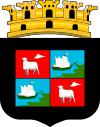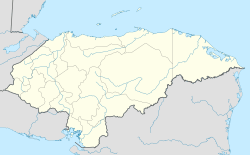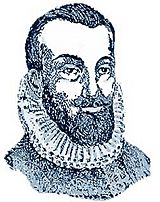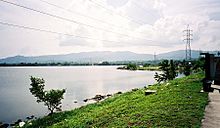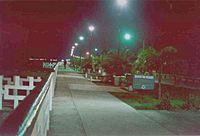Puerto Cortés facts for kids
Quick facts for kids
Puerto Cortés
Puerto Caballos
|
||
|---|---|---|
|
Municipality
|
||
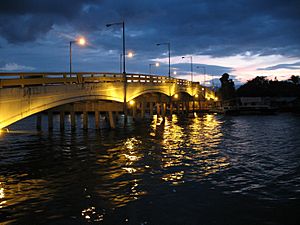
The bridge in Puerto Cortés
|
||
|
||
| Nickname(s):
"El Puerto", "Puerto Caballos"
|
||
| Country | ||
| Department | Cortés | |
| Founded | 1524 | |
| Area | ||
| • Municipality | 383 km2 (148 sq mi) | |
| Population
(2023 projection)
|
||
| • Municipality | 142,311 | |
| • Density | 371.6/km2 (962.4/sq mi) | |
| • Urban | 97,506 | |
| Time zone | UTC-6 (América Central) | |
Puerto Cortés, first known as Puerto de Caballos, is a port city in Honduras. It is located on the northern Caribbean coast. The city sits right on the Laguna de Alvarado. It is north of San Pedro Sula and east of Omoa. The city has a natural bay, which is great for ships.
Puerto Cortés was founded a long time ago, when Europeans first came to the area. It grew very quickly in the 1900s. This growth was helped by the railroad and banana farming. Today, its seaport is the busiest in Central America. It is also the 36th largest port in the world by traffic volume. In 2023, the city of Puerto Cortés had about 73,150 people living there.
Contents
A Look Back: The History of Puerto Cortés
The city was first founded in 1524 by Gil González Dávila. He named it Villa de la Natividad de Nuestra Señora. This area is now known as Cieneguita.
In 1526, Hernán Cortés arrived from Mexico. He came to deal with González Dávila. When Cortés started unloading horses from his ships, some horses drowned. Because of this, Cortés called the place Puerto Caballos, which means "Port of Horses."
By 1533, a local leader named Çiçumba attacked and destroyed the town. He reportedly captured a woman from Spain. After Çiçumba was defeated in 1536 by Pedro de Alvarado, a new town was built. This new town, also called Puerto de Caballos, was located on the southern shore of the Laguna de Alvarado.
English forces attacked Puerto Caballos, just like other places on the Honduran coast. Christopher Newport took over the town for a short time in 1603. This was part of the Anglo–Spanish War. The town was often attacked by pirates. Because of this, not many people lived there permanently in the 1500s and 1600s. People from San Pedro would only come to the coast when a ship arrived. In 1869, Puerto Caballos changed its name to Puerto Cortés. This was done to honor Hernán Cortés.
Bananas, Railroads, and Growth in the 1900s
In 1850, there was a plan to build a railroad across Honduras. This "inter-oceanic railway" was needed to move goods from the Atlantic to the Pacific. This was because of the United States Gold Rush of 1849. The railroad was planned to start at Puerto Cortés.
Building the rail line had many problems. In 1876, President Marco Aurelio Soto took control of the railroad. It only reached San Pedro Sula. When the Panama Canal was finished in 1903, the idea of connecting the coasts by rail was stopped. The area around Puerto Cortés then became a major center for growing and exporting bananas. The port became a leader in sending bananas out of the country.
Foreign companies soon controlled the banana export business. One of the first was William Frederick Streich in 1902. His company was near Omoa and the Cuyamel River. However, in 1910, Samuel Zemurray's Cuyamel Fruit Company bought Streich's land. Cuyamel Fruit Company grew quickly. They gained more land and special tax deals. This happened especially after Zemurray helped Manuel Bonilla become president. Bonilla gave Cuyamel more land and removed their tax payments.
Cuyamel had built port facilities in Omoa. But they also started using the port in Puerto Cortés. Soon, they controlled it so much that local shippers had to ask Cuyamel for permission to use the port. In 1918, Cuyamel built a railroad line into Puerto Cortés. By 1920, they controlled the National Railroad. Through this and other secret railroads, the company controlled almost all transport to the port. When Zemurray sold Cuyamel Fruit to United Fruit in 1929, this huge company had a lot of power in Puerto Cortés and all of Honduras.
Life in the City
Every August, Puerto Cortés celebrates its local festivals for two weeks. The last day, a Saturday, is called Noche Veneciana (which means 'Venice Night'). August 15th is a local holiday. It honors the Virgen de la Asunción, who is Puerto Cortés's patron saint.
In September 2001, the Laguna de Alvarado Bridge was rebuilt. The old bridge was 50 years old and was badly damaged by Hurricane Mitch in 1998. A concrete wall was built near the northern end of the bridge. This wall protects part of the coastline in the bay. It is known as El Malecón, which means 'The Breakwater' in Spanish.
Honduras's first four-lane highway opened in 1996. It connects Puerto Cortés with the city of San Pedro Sula.
The Seaport
In 1966, the Empresa Nacional Portuaria was created. This is Honduras's National Port Authority. A special free trade zone was set up in 1976.
Puerto Cortés is the 36th largest seaport in the world for exporting containers to the USA. This is based on the amount of goods shipped.
Because it is close to US seaports and has good facilities, Puerto Cortés was chosen for the US Container Security Initiative (CSI). It was the first port in Central America to join this program. In December 2005, the US government signed a deal with Honduras. A US Customs Office was opened in Puerto Cortés. This means all containers from Puerto Cortés going to the US are checked by US Customs officials right there in Honduras.
In March 2007, three special machines called RPMs (Radiation Portal Monitors) were installed. The US DOE put them there. They check all containers going to the USA for dangerous radioactive materials. These machines started working on April 2, 2007.
Sports in Puerto Cortés
Puerto Cortés is home to a football (soccer) team called Platense. They won their first Honduran National Football Championship in 1966. In 2001, the team won their second national championship. They play their home games at the Estadio Excélsior. Another football club, Atlético Portuario, was also based in the city for a short time.
Famous People from Puerto Cortés
- Édgar Álvarez – A football player.
- Julio César de León – A football player.
- Roger Espinoza – A football player.
- Zora Neale Hurston – An African American writer and scholar. She lived in Puerto Cortés from 1947 to 1948 while writing her book Seraph on the Suwanee.
- Vilma Cecilia Morales – A former President of Honduras's Supreme Court of Justice.
- Bertha Zúñiga
Schools in Puerto Cortés
- Atlantic Bilingual School (ABS) is a private school. It teaches in both English and Spanish.
- There is an elementary school named República de Mexico.
- Another elementary school is named República de Chile.
- There is an elementary school named Saint Martin de Porres. It is named after a Saint from Peru.
- A private Catholic high school is named Sacred Heart of Jesus (Sagrado Corazón de Jesús).
- There is a high school academy named Saint John Bosco. It is named after that saint.
- A bilingual school (elementary, junior high, and high school) is named Saint John the Baptist. It is named after this Prophet.
- There is a high school named after former US president Franklin Delano Roosevelt.
- The Mary Frenter Bilingual School is a private bilingual high school. It is run by Worldwide Heart to Heart Ministries.
Interesting Facts About Puerto Cortés
- There is a beach called La Coca-Cola. It got its name because a Coca-Cola bottling plant was located there.
- In the 1930s, a small whale was caught in the bay of Puerto Cortés. This was very unusual, as whales are not normally found in the Caribbean Sea.
- The USS Hornet aircraft carrier visited Puerto Cortés in 1963.
- The football stadium is called Estadio Excelsior. In 1965, an Argentine professional football club, Chacarita Juniors, played there. They beat Platense 2–1.
- Since 1986, the city of Puerto Cortés gets four percent (4%) of all money collected by the Honduras Custom office in the port. It also gets four percent (4%) of all money collected by La Empresa Nacional Portuaria (Honduras Port Authority) in the Seaport. This payment is known as El Cuatro por Ciento (The Four Percent). Two other cities where the Port Authority operates also receive this percentage.
Medical Services
Puerto Cortés has many medical health care services.
Public Hospitals:
- Centro Medico Litoral Atlántico
- CEMECO
- CEDEM
- Centro Medico Handal
- Hospital IHSS (Public)
- Hospital del Area (Public)
Rehabilitation Center:
- Centro de Rehabilitacion Integral de Puerto Cortes (CRIPCO)
See also
 In Spanish: Puerto Cortés para niños
In Spanish: Puerto Cortés para niños


